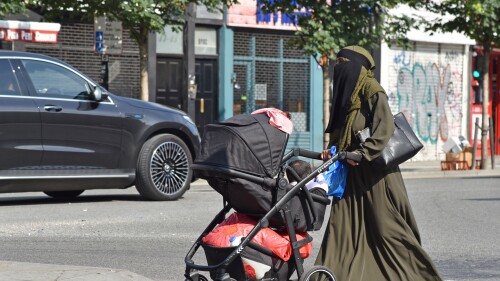Iraqi Archbishop Bashar Warda made the following observation during a recent speech: “Having faced for 1,400 years the slow-motion genocide that began long before the ongoing ISIS genocide today, the time for excusing this inhuman behavior and its causes is long since passed.”
That Muslims have cleansed non-Muslim peoples by the sword since the seventh century to the present is of course factually well-documented. But what of the more subtle “slow-motion genocide”? How does that work? The answer is connected to another question: Why did so many non-Muslims become Muslim in the first place?
Many modern day Muslims and Western apologists claim that the ancestors of today’s 1.5 billion Muslims converted to Islam due to its intrinsic appeal; that the modern day coercion and persecution committed by the Islamic State and others is an aberration.
Conversely, many Muslim and non-Muslim historical records make clear that most people embraced Islam, not out of sincere faith, but for a myriad of reasons—from converting in order to enjoy the boons of being on the “winning team” to converting in order to evade the dooms of being on the “losing team.”
Because well documented facts have little influence on the modern West’s ahistorical sense of reality, happily the exercise of common sense validates what history records: the Islamic world is built atop, not so much the physical genocide of infidels, but the spiritual and cultural genocide of their identity. This killing of two birds with one stone was always more advantageous for Islam, for while the non-Muslim’s former religious/cultural identity is purged, his body remains to strengthen the ranks of Islam.
Consider Egypt. In the 7th century, when Islam was being formulated, it had been Christian for centuries, before most of Europe had converted. Alexandria was the most important ecclesiastical center of ancient Christian learning and, along with Rome and Antioch, one of the original three sees. Writing around the year 400—roughly two-and-a-half centuries before the Arab invasions—John Cassian, a European, observed that “the traveler from Alexandria in the north to Luxor in the south would have in his ears along the whole journey, the sounds of prayers and hymns of the monks, scattered in the desert, from the monasteries and from the caves, from monks, hermits, and anchorites.” In recent times, both the oldest parchment to contain words from the Gospel (dating to the 1stcentury) and the oldest image of Christ were discovered in separate regions of Egypt.
What made such an ancient and heavily Christian nation become Islamic? More specifically, what made the ancestors of today’s Egyptian Muslims—most of who were Coptic Christians—slough off their identity and become Muslim?
Before answering these questions another overlooked factor needs to be kept in mind. From the time Islam conquered Egypt (and much of the then known Christian world) in the 7th century and well into the premodern era, religion was not something to be casually adhered to or changed, as it is today in the West. People then were sincere believers; there was no alternative narrative—no so-called “science vs God” claims.
Despite the many movies that project a sort of cynical modernity onto medieval Christians—such as the Kingdom of Heaven’s lead character, the “nuanced” and “secularized” Christian, Balian—"for medieval people, religion was not something one just did at church. It was their science, their philosophy, their politics, their identity, and their hope for salvation. It was not a personal preference but an abiding and universal truth.”
In other words, even if Islam offered intrinsic appeal, the idea that pre-modern Christians were “free” to choose to convert—free of guilt, free of fear from hell, free of existential trauma that comes with apostasy—is anachronistic and implausible. Again, those who change religions as often as they change shoes may have great difficulty in fully appreciating this idea; but it is true nonetheless.
If Europeans were this dedicated to Christianity in the medieval era, naturally so too were the Copts of Egypt who became Christian centuries earlier. What, then, made them convert to Islam en ma is the question before us?
Is it true, to quote Georgetown University professor John Esposito, that Christians “were free to practice their faith to worship and be governed by their religious leaders and laws in such areas as marriage, divorce, and inheritance. In exchange, they were required to pay tribute, a poll tax (jizya) that entitled them to Muslim protection from outside aggression and exempted them from military service”? And yet, though left in peace and unpressured, Egypt’s original Christians found the new creed of sword-swinging, camel-riding Arabs so intrinsically appealing that they willingly apostatized en masse from the religion of their forefathers?
In fact, common sense suggests that nothing less than extremely severe circumstances and hardships—persecution—prompted the Copts and others to convert to Islam.
As mentioned, for the historian who reads the primary sources—as opposed to the mainstream works of fiction being peddled as “history” by the likes of Karen Armstrong and others—the above exercise in common sense is superfluous.
For the original sources make abundantly clear that, while Egypt’s Copts acquiesced to dhimmi status—constantly paying large sums of extortion money and accepting life as third class subjects with few rights simply to remain Christian—bouts of extreme persecution regularly flared up. And with each one, more and more Christians converted to Islam in order to find relief.
One telling example: in Muslim historian Taqi al-Din al-Maqrizi’s (d. 1442) authoritative history of Egypt, anecdote after anecdote is recorded of Muslims burning churches, slaughtering Christians, and enslaving their women and children. The only escape then—as it is increasingly today—was for Christians to convert to Islam.
After recording one particularly egregious bout of persecution, where countless Christians were slaughtered, enslaved, and raped, and where reportedly some 30,000 churches in Egypt and Syria were destroyed—a staggering number that further indicates how Christian the Near East was before Islam—the pious Muslim historian makes clear why Christians converted: “Under these circumstances a great many Christians became Muslims” (emphasis added).
Thus while many Christians were physically purged, many more were spiritually/culturally purged into becoming Muslims. According to internationally recognized definitions, both are forms of genocide. “Killing” and causing “serious bodily or mental harm” to members of any group of people—in this case “infidels” or non-Muslims—are the first two of five legal definitions of genocide.
The third definition encapsulates the “slow-motion genocide": “Deliberately inflicting on the group conditions of life calculated to bring about its physical destruction in whole or in part” (emphasis added). This is exactly what Islam did to its conquered non-Muslim subjects throughout the centuries; it imposed negative “conditions of life calculated” to prompt infidels to abandon their former identities and heritage in order to reap the benefits of joining Islam (which included the instant cessation of persecution and discrimination). Indeed, it is no coincidence that the Sharia-compliant “conditions of life calculated” to make the dhimmi’s existence so intolerable were and are known as the “Conditions of Omar.”
Thus if bouts of wholesale persecution were haphazard, the entrenched dhimmi system, built atop the “Conditions of Omar,” was always present, always “inspiring” increasingly impoverished non-Muslim dhimmis to convert to Islam over the centuries, so that nations such as Egypt which were about 95 percent Christian in the 7th century are today only about 10 percent.
Consider the words of Alfred Butler, a 19th century historian writing before political correctness came to dominate academia. In The Arab Conquest of Egypt, he highlights the “vicious system of bribing the Christians into conversion":
[A]lthough religious freedom was in theory secured for the Copts under the capitulation, it soon proved in fact to be shadowy and illusory. For a religious freedom which became identified with social bondage and with financial bondage could have neither substance nor vitality. As Islam spread, the social pressure upon the Copts became enormous, while the financial pressure at least seemed harder to resist, as the number of Christians or Jews who were liable for the poll-tax [jizya] diminished year by year, and their isolation became more conspicuous. . . . [T]he burdens of the Christians grew heavier in proportion as their numbers lessened [that is, the more Christians converted to Islam, the more the burdens on the remaining few grew]. The wonder, therefore, is not that so many Copts yielded to the current which bore them with sweeping force over to Islam, but that so great a multitude of Christians stood firmly against the stream, nor have all the storms of thirteen centuries moved their faith from the rock of its foundation.
Although the above exposition concerns Egypt, the same “slow motion” paradigm of genocide applies to the rest of conquered Christian and non-Muslim lands in general. Today the whole of North Africa and Turkey are about 95% Muslim—even though along with Egypt both regions once formed the heart of the Christian world. (St. Augustine—the father of Western Christian theology—hailed from modern day Algeria; and Anatolia—"Turkey"—is the site of the oldest churches which received epistles from the apostles.)
Moving to the modern era, consider the recent words of noted author, journalist and Pakistani politician, Farahnaz Ispahani:
Right before the partition of India and Pakistan, we had a very healthy balance of religions other than Islam. Hindus, Sikhs, Christians, Zoroastrians. [Now] Pakistan goes from 23 per cent [non-Muslim], which is almost a quarter of its population, to three per cent today. I call it a “drip drip genocide,” because it’s the most dangerous kind of wiping out of religious communities… It doesn’t happen in one day. It doesn’t happen over a few months [emphasis added].
In short, it is no exaggeration to say that “the Islamic world” would be a fraction of its size—it might not exist at all—were it not for the fact that non-Muslims were less purged by the sword, and more pressured into self-purging their “infidel” identities to evade the sword and a host of other disadvantages, thereby swelling the ranks of Islam.







